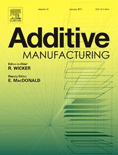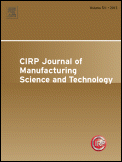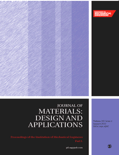
Additive Manufacturing
Scope & Guideline
Elevating Standards in Additive Manufacturing Research
Introduction
Aims and Scopes
- Materials Development and Characterization:
Research on new materials suitable for additive manufacturing, including polymers, metals, ceramics, and composites, focusing on their mechanical, thermal, and chemical properties. - Process Optimization and Innovation:
Studies aimed at improving additive manufacturing processes, including Fused Deposition Modeling (FDM), Laser Powder Bed Fusion (LPBF), and Binder Jetting, through optimization of parameters and innovative methodologies. - Application in Biomedical Engineering:
Exploration of additive manufacturing applications in the biomedical field, such as tissue engineering, drug delivery systems, and the creation of custom prosthetics. - Sustainability and Eco-friendly Practices:
Research focused on sustainable practices in additive manufacturing, including the use of biodegradable materials, recycling processes, and energy-efficient manufacturing techniques. - Integration of Advanced Technologies:
The incorporation of technologies such as artificial intelligence, machine learning, and digital twins to enhance the design, monitoring, and optimization of additive manufacturing processes. - Multiscale and Multifunctional Structures:
Development of complex, multifunctional, and hierarchical structures that utilize the unique capabilities of additive manufacturing to meet specific engineering requirements.
Trending and Emerging
- 4D Printing and Smart Materials:
Research on four-dimensional (4D) printing, which involves materials that can change shape or properties in response to external stimuli, is gaining traction. This trend reflects the growing interest in creating intelligent systems that can adapt and respond dynamically. - Bioprinting and Tissue Engineering:
The focus on bioprinting and the development of tissue-engineered constructs is rapidly expanding, driven by advances in materials and methods that allow for the creation of complex biological structures. - Digital Manufacturing and Automation:
The integration of digital technologies such as AI, machine learning, and automation in additive manufacturing processes is emerging as a key area of interest, enhancing efficiency and enabling real-time monitoring. - Sustainable Practices and Materials:
Increased emphasis on sustainability in additive manufacturing, including the development of eco-friendly materials and processes, reflects a growing awareness of environmental impacts and the need for sustainable manufacturing solutions. - Advanced Applications in Aerospace and Automotive Industries:
There is a rising trend in the application of additive manufacturing in the aerospace and automotive sectors, focusing on lightweight structures, complex geometries, and performance optimization. - Simulation and Modeling Techniques:
The use of advanced simulation and modeling techniques to predict the behavior of materials and processes in additive manufacturing is becoming increasingly important, driving innovation and improving manufacturing outcomes.
Declining or Waning
- Traditional Manufacturing Comparisons:
Research comparing additive manufacturing with traditional manufacturing methods, such as machining or injection molding, has decreased as the industry shifts focus to hybrid manufacturing techniques that combine both approaches. - Basic Process Descriptions and Overviews:
Papers providing general descriptions or reviews of additive manufacturing processes are becoming less common as researchers seek more specific insights and advanced applications rather than foundational knowledge. - Low-Technology Applications:
There is a marked decline in studies related to low-technology applications of additive manufacturing, such as basic prototyping, as the focus shifts towards high-value applications in specialized industries. - Single Material Systems:
Research on single material systems is less prevalent as the trend moves towards multi-material and composite structures that leverage the capabilities of additive manufacturing to create more complex and functional components.
Similar Journals

Functional Composites and Structures
Elevating Material Science through Collaborative Insights.Functional Composites and Structures is a prestigious academic journal published by IOP Publishing Ltd, dedicated to advancing the field of materials science with a focus on innovative composite materials and their structural applications. Established in 2019 and running through 2024, this journal uniquely bridges several disciplines, consistently ranking in the Q2 quartile across key categories including Ceramics and Composites, Electronic, Optical and Magnetic Materials, and Mechanics of Materials. With a commendable Scopus rank that places it within the top tiers of its field, the journal is instrumental for researchers, engineers, and scholars seeking to explore the latest developments in material properties, functionality, and applications. Although access options are not specified, the open-access nature of the journal promotes wider dissemination and engagement with cutting-edge research. As the demand for smarter, more efficient materials continues to grow, Functional Composites and Structures serves as a vital resource for fostering collaboration and driving innovation in material sciences.

Materiali in Tehnologije
Catalyzing Innovations in Material TechnologiesMateriali in Tehnologije is a distinguished peer-reviewed journal dedicated to the field of materials science, focusing specifically on metals and polymers. Published by the Institute for Metals and Materials Technology in Slovenia, this open-access journal has been at the forefront of disseminating research findings and innovative technologies since 2000. With a current impact factor that reflects its increasing visibility in the academic community, Materiali in Tehnologije serves as an invaluable resource for researchers, professionals, and students alike, encompassing a wide array of studies in the categories of Metals and Alloys, as well as Polymers and Plastics. The journal is indexed in Scopus, highlighting its relevance and contribution to the field, particularly with its ranks of Q3 in Metals and Alloys and Q4 in Polymers and Plastics. As it converges towards 2024, Materiali in Tehnologije continues to be a pivotal platform for knowledge exchange, encouraging advancements in materials research and technology.

CIRP Journal of Manufacturing Science and Technology
Shaping the Future of Industrial Engineering ResearchCIRP Journal of Manufacturing Science and Technology is a highly respected publication in the field of Industrial and Manufacturing Engineering, published by Elsevier in the Netherlands. With a Q1 ranking in its category and a Scopus ranking of #51 out of 384, the journal reflects its prominence and contribution to the scientific community, boasting an impressive percentile ranking of 86th. Since its inception in 2008, the journal has served as a pivotal platform for disseminating cutting-edge research in manufacturing science, promoting advancements in technology and process optimization. While not an open-access journal, the content is available through institutional subscriptions, ensuring that critical findings reach a wide audience of researchers, professionals, and students. The CIRP Journal aims to foster innovation and collaboration among experts, making it an essential resource for those looking to stay at the forefront of manufacturing research and technology.

MATERIALE PLASTICE
Unveiling the Potential of Advanced MaterialsMATERIALE PLASTICE is a distinguished academic journal published by REVISTA CHIMIE SRL in Romania, focusing on the fields of Chemistry, Materials Science, and Engineering. With an ISSN of 0025-5289 and an E-ISSN of 2668-8220, this journal has a historical commitment to advancing the study of polymers and plastics since its inception in the early 1970s. Although classified in the Q4 category across multiple disciplines including miscellaneous chemistry and materials chemistry as of 2023, it serves as an important forum for researchers and professionals dedicated to innovative materials research and development. The journal’s resources, though not openly accessible, are pivotal for scholars seeking to deepen their knowledge in the mechanics of materials and interdisciplinary applications. MATERIALE PLASTICE is not only a repository of significant research findings but also a platform for fostering collaboration and discussion among a global audience that continues to strive for scientific excellence in polymer and materials studies.

MANUFACTURING ENGINEERING
Pioneering Research for Tomorrow's Manufacturing ChallengesManufacturing Engineering is a pivotal journal specializing in the fields of Industrial and Manufacturing Engineering, as well as Mechanical Engineering, with a rich history of publication since its inception in 1975. Published by the esteemed Société des Ingénieurs de Fabrication (SME), this journal plays a crucial role in disseminating innovative research, practical applications, and emerging technologies that shape the manufacturing sector. Despite its recent positioning in the Q4 quartile rankings on Scopus, the journal serves as a platform for rigorous peer-reviewed articles that contribute to the academic dialogue and bolster advancements in manufacturing practices. The journal operates without open access options, making it an essential resource for institutions and professionals looking to stay informed within the manufacturing domain. With a dedicated audience comprising researchers, engineers, and industry professionals, Manufacturing Engineering continues to address the evolving challenges and opportunities in manufacturing, fostering an environment ripe for collaboration and exploration.

PROCEEDINGS OF THE INSTITUTION OF MECHANICAL ENGINEERS PART L-JOURNAL OF MATERIALS-DESIGN AND APPLICATIONS
Catalyzing Breakthroughs in Mechanical Engineering and Materials SciencePROCEEDINGS OF THE INSTITUTION OF MECHANICAL ENGINEERS PART L-JOURNAL OF MATERIALS-DESIGN AND APPLICATIONS is a prestigious academic journal published by SAGE PUBLICATIONS LTD, focusing on the dynamic fields of mechanical engineering and materials science. With an impressive impact factor reflective of its rigorous scholarly contributions, this journal serves as a vital platform for the dissemination of innovative research and practical applications in materials design and engineering processes. Since its inception in 1999 and continuing through 2024, it has maintained a robust reputation, achieving a Q2 ranking in both Materials Science (miscellaneous) and Mechanical Engineering categories, as well as commendable Scopus ranks that place it in the top percentiles of its fields. Located in the United Kingdom, the journal encourages submissions from researchers and professionals who are seeking to advance their understanding of materials applications while fostering interdisciplinary collaboration. Although it currently operates under traditional access terms, the journal prioritizes impactful research that addresses contemporary challenges in design and manufacturing, ensuring that it remains a must-read for anyone invested in the innovations shaping our technological landscape.

Advanced Manufacturing-Polymer & Composites Science
Connecting Research with Real-World ImpactAdvanced Manufacturing-Polymer & Composites Science, published by Taylor & Francis Ltd, is a prominent open-access journal dedicated to the cutting-edge fields of polymer and composite materials in advanced manufacturing. With an ISSN of 2055-0340 and an E-ISSN of 2055-0359, this journal has been providing researchers, professionals, and students critical insights since its inception in 2015. The journal is characterized by its pivotal role in disseminating high-quality research that intersects with crucial areas such as Electrical and Electronic Engineering, Management of Technology and Innovation, and Polymers and Plastics, as indicated by its Q3 and Q2 rankings across these categories in 2023. In addition, it has established a significant presence in Scopus rankings, reflecting its contribution to the academic community with specific ranks in the top half of its fields. Recognizing the importance of open access, the journal fosters wider dissemination of knowledge, allowing global access to groundbreaking studies that influence both research and practical applications. Operating from the United Kingdom, Advanced Manufacturing-Polymer & Composites Science continues to pave the way for innovation and collaboration in the field, making it an essential resource for anyone involved in materials science and engineering.

Virtual and Physical Prototyping
Exploring the Convergence of Virtual and Physical RealmsVirtual and Physical Prototyping is a premier scholarly journal published by Taylor & Francis Ltd, which has established itself as a leading platform for innovative research in the fields of Computer Graphics, Computer-Aided Design, Industrial and Manufacturing Engineering, Modeling and Simulation, and Signal Processing. Since its inception in 2006, the journal has gained significant recognition, currently ranked in the Q1 quartile in multiple categories, reflecting its high impact and rigorous standards of scholarship. Now an Open Access journal as of 2023, it provides a unique opportunity for researchers, professionals, and students to share their work widely and engage with a global audience. With its strategic emphasis on the convergence of virtual and physical prototyping technologies, this journal contributes vital knowledge and insights that drive innovation and development in manufacturing processes and design methodologies. Located in the United Kingdom, its comprehensive approach to both theoretical and practical aspects of prototyping ensures that it remains an essential resource for advancing the respective fields it represents.

STROJNISKI VESTNIK-JOURNAL OF MECHANICAL ENGINEERING
Cultivating a Community of Mechanical Engineering ExpertsSTROJNISKI VESTNIK-JOURNAL OF MECHANICAL ENGINEERING is a prestigious publication that has been disseminating cutting-edge research in the field of mechanical engineering since 1974. Published by the Association of Mechanical Engineers Technicians Slovenia, this journal serves as a critical platform for professionals, researchers, and students aiming to explore advancements in mechanical engineering and mechanics of materials. With a category ranking in the Q3 quartile for both Mechanical Engineering and Mechanics of Materials, the journal reflects a robust engagement with contemporary research and practices, contributing to the ongoing discourse within these vital disciplines. Although currently not open access, the journal is committed to providing high-quality, peer-reviewed articles that facilitate knowledge sharing and innovation. It is indexed in Scopus, maintaining respectable standings within its categories, thereby underlining its importance and impact in the global academic community.

Journal of Metals Materials and Minerals
Unveiling Breakthroughs in Materials and Mineral StudiesJournal of Metals Materials and Minerals (ISSN: 0857-6149) is a renowned academic publication dedicated to the interdisciplinary fields of metallurgical science, materials engineering, and mineralogy. Published by Chulalongkorn University, Metallurgy & Materials Science Research Institute in Thailand, this journal serves as a pivotal platform for researchers to disseminate their findings and explore innovative applications related to metals, ceramics, polymers, and biomaterials. Although the journal does not currently adopt an open-access model, it provides insightful content that facilitates knowledge sharing among professionals and academics alike. The journal has established its credibility with impressive Scopus ranking percentiles, particularly in categories such as Metals and Alloys and Ceramics and Composites. With an emphasis on advancing the understanding of materials science from 2017 to 2024, the Journal of Metals Materials and Minerals remains an essential resource for those striving to contribute to and stay informed about the latest trends and breakthroughs in these dynamic fields.